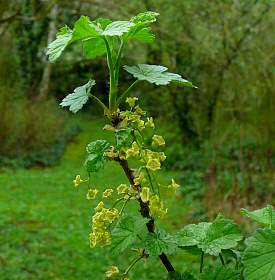Black currant, Ribes nigrum
shrub of the family Grossulariacées formerly Saxifragaceae ( Currant, Black currant)  Etymology: The name "currant" comes from Latin cassia, a reference to another plant, that shares the same medicinal properties. Etymology: The name "currant" comes from Latin cassia, a reference to another plant, that shares the same medicinal properties.
Origin: Northern Europe and Asia. In Europe, it colonizes easily wet alder.
Habitat: The black currant prefers damp, shady places and light soil rich in humus, drained, neutral pH. It does not support high temperatures and supports in contrary, the winter cold.
Hardiness: Zone 6 (it supports cold to -23 ° or - 9°F).
Maximum size: 1.5 m tall.
Habit: Bushy.
Deciduous foliage. Lobed opposite leaves (like those of Norway maple). The crushed leaves emit a pleasant fragrance.
Flowers in spring. Yellowish-green. The black currant with small berries is self-fertile but most species require another variety nearby for pollination.
Fruit: small black berries (dark blue), called cassis or blackcurrant, grouped in clusters. The blackcurrant is rich in tannins. It contains a thick purple juice, sour, rich in vitamin C (200 mg/100 g), more than the kiwi (80 mg) and orange (50 mg). It also contains plenty of fiber, which makes it very digestible.
Use: shrub fruit, valued for the fruit, cassis.
The blackcurrant is not consumed fresh, unlike the blueberry because it is slightly acidic and it contains a pip embarrassing for consumption. The blackcurrant is used for making liquor syrups, juices, ice creams, sorbets, sauces, jams.
The black currant is grown in Burgundy and in the Dijon region. Since at least the eighteenth century: we make the famous "crème de cassis", an alcohol in which were macerated blackcurrants. Mixed with white wine or sparkling wine and notably champagne particular, we get a cool soft drink. It is a waiter who invented the recipe for "blanc'cass" in 1904. Canon Kir, mayor of Dijon from 1945 to 1967, continued the tradition of the previous mayor to serve at official receptions, and now, this drink is called in France, kir, white wine kir or champagne kir. Blackcurrant also has medicinal properties to fight against rheumatic pains, sore throat and cough caused by colds or flu, or diarrhea. Finally, the black currant seed oil is rich in gamma-linolenic acid (GLA), a fatty acid omega-6, but it is not sold. Diseases and pests:
anthracnose, powdery mildew, aphids and yellows. Planting tips: The black currants can be repotted in the spring or fall.
The blackcurrant is easy to propagate by cuttings, layering or seeds. Cuttings or layers bear fruit in 2-3 years when the seedlings require 4 to 5 years. Maintenance Tips:
Prune your currant in winter (January-February) by folding the main branches to a third of their length and cutting the old branches. The blackcurrant supports severe pruning. Allow three eyes on the secondary branches. Species, varieties interesting:
* Ribes americanum Mill. - American black currant
* Ribes bracteosum Dougl. Californian Blackcurrant
* Ribes × cuverwelli Macfarl. (Ribes nigrum × Ribes uva-crispa)
* Ribes fragrans Pall.
* Ribes × fuscencens jancz.
* Ribes hudsonianum Richards
* Ribes nigrum L. - European black currant
* Ribes ussuriensise jancz.
* Ribes 'Josta' (Ribes nigrum × tetraploid Ribes uva-crispa) × (Ribes nigrum Ribes divaricatum × tetraploid)
* Ribes 'Kroma' (Ribes nigrum Ribes niveum × tetraploid) |